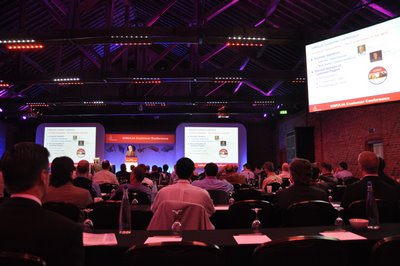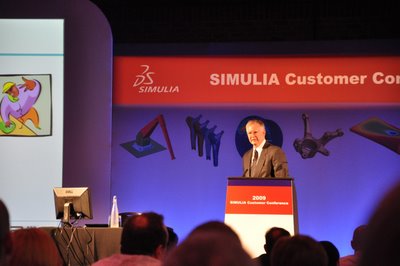Dassault Systemes‘ Simulia group is running its Simulia Customer Conference event in central London over the next few days and I’ve been sitting in on the presentations for the first day – for those involved with Simulia or perhaps Abaqus, these events were once know as the Abaqus user conference, but as ever, times change. While the initial introductions from the Simulia team brought a pretty standard update on the roadmap for the product set and the company as a whole, The keynote of interest for me was by Kelly Pike, Advisor R & D at Abbott Vascular, with his presentation entitled, “Is there a stent in your future?”
Kelly Pike, Advisor R & D at Abbott Vascular.
Headquartered in California, but operating globally, the company 6,000 employees world wide supporting the design and manufacturing of interventional devices. The design and manufacturing team is then supported by just seven FE analysts/ within a $29Bn business. The key challenge that Pike’s team are facing is the move away from metal alloy-based stents, into the realms of plastics.
His presentation was fascinating, if not purely for the human interest that the Life Sciences industry represents, but also the technical challenges they’ve encountered. Consider the stent. A microscopic device, inserted into the arteries to alleviate blockages and restriction of blood at various points around the body. When you’re dealing with devices that operate in a highly non-linear manner, with dimensions in the region of 0.004″, its clear that there are huge issues. But for me, two things from his presentation stood out.
Firstly, he described the need to conform to the FDA regulations (as stated in the FDA guidance 1545.pdf), specifically, the need to be able to “clearly identify and support all inputs and assumptions used in your analysis.” He described how simulation gives organizations working in this field the ability to both fully document their work, but also have an environment in which decisions and assumptions are tracked and fully auditable. This is something that resonates nicely with the topic of Simulation Life-cycle Management as espoused during the corporate updates on the Simulia business update at the head of the day.
Another example of perhaps often hidden benefits of simulation within the medical field was contained within a recent project to bring a Vessel closure device to market. When you’re inserting devices, such as stents, in major arteries, there is clearly an entry/exit wound that needs to be closed quickly and efficiently. Rather than relying on the traditional methods of having a qualified member of medical staff applying pressure until the blood has stopped flowing from that point, the company has developed a Vessel Closure device that closes off the wall of the artery. During production kick off and testing, it was found that there was a serious issue with fracture that could cause failure and the natural assumption was made that the design was in key cause. Using Abaqus, the team simulated the device in deployment and use and discovered that the design was sound, but rather the weakness was introduced later in on the processing stage as the devices were being prepared for use.
The final point of interest is how Pike’s team is moving away from a server-based environment to a workstation-based working method. According to Pike and much to his surprise, they’ve discovered that there’s an interesting relationship between using a central server and a much more localized hardware adoption strategy – comparing a $100,000 server set-up to the use of $7,000 workstations.
What was interesting is that the team uses a range of tools, from Abaqus, through SolidWorks and CosmosWorks, Patran and HyperMesh as well as all the normal reporting tools. When talking a look at the use of workstations, where everything is localized and all tools are instantly available, they’ve found that they can get the job done, from receiving the requirement for an analysis task to delivering the report, that the workstation set-up delivers things much more quickly. and of course, in these cost conscious times, setting up a seven person team with 7,000 workstations is much more effective than using a $100,000 server.








